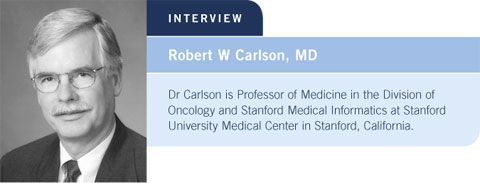
 |
||||||||||||||

| Tracks 1-7 | ||||||||||||||||
|
Select Excerpts from the Interview
Track 2
![]() DR CARLSON: The strategies have never truly been studied in a randomized
fashion. The BIG 1-98 trial will give us the first look at directly comparing
these strategies (Thürlimann 2005). The issue is whether tamoxifen is doing
something biologically to the tumor that primes it or sensitizes it to profound
estrogen deprivation, which characterizes the activity of an aromatase inhibitor.
DR CARLSON: The strategies have never truly been studied in a randomized
fashion. The BIG 1-98 trial will give us the first look at directly comparing
these strategies (Thürlimann 2005). The issue is whether tamoxifen is doing
something biologically to the tumor that primes it or sensitizes it to profound
estrogen deprivation, which characterizes the activity of an aromatase inhibitor.
![]() DR LOVE: That would kick in after two to three years, but there would be
more recurrences during the first two to three years.
DR LOVE: That would kick in after two to three years, but there would be
more recurrences during the first two to three years.
![]() DR CARLSON: That’s correct. And is that priming by tamoxifen — if it
happens, and I think that’s questionable — great enough that, over the ensuing
period of time with the aromatase inhibitor, that you “catch up” with the women who have experienced recurrences during the first two to three years?
The question is: Is there really something that tamoxifen is doing to prime the
breast cancer cells, which then makes the aromatase inhibitor more effective?
Or is it, rather, that the population of women and the characteristics of their
breast cancer, specifically, change over time in a way that we would expect to
make the aromatase inhibitors, or any hormonal therapy, more effective?
DR CARLSON: That’s correct. And is that priming by tamoxifen — if it
happens, and I think that’s questionable — great enough that, over the ensuing
period of time with the aromatase inhibitor, that you “catch up” with the women who have experienced recurrences during the first two to three years?
The question is: Is there really something that tamoxifen is doing to prime the
breast cancer cells, which then makes the aromatase inhibitor more effective?
Or is it, rather, that the population of women and the characteristics of their
breast cancer, specifically, change over time in a way that we would expect to
make the aromatase inhibitors, or any hormonal therapy, more effective?
I believe there is a substantial amount of data that would support the “selection bias theory” — the population of breast cancers is changing over time. You would expect the endocrine-resistant, receptor-positive breast cancers to recur earlier. So those women are removed from the denominator, and if you really do have a sensitive population and an insensitive population of hormone receptor-positive tumors, you should expect — even if there’s no difference in efficacy between the hormonal therapies — to see an increasing effect the later in time you initiate the therapy.
![]() DR LOVE: So what would you recommend for practical purposes?
DR LOVE: So what would you recommend for practical purposes?
![]() DR CARLSON: The majority of my patients are given a prescription for an
aromatase inhibitor; typically, that would be anastrozole in my practice.
DR CARLSON: The majority of my patients are given a prescription for an
aromatase inhibitor; typically, that would be anastrozole in my practice.
Track 4
![]() DR CARLSON: None of the published aromatase inhibitor trials have enrolled
women who were rendered postmenopausal by the treating oncologist. Therefore,
this is a population of women who do not meet the eligibility criteria for
the aromatase inhibitor trials.
DR CARLSON: None of the published aromatase inhibitor trials have enrolled
women who were rendered postmenopausal by the treating oncologist. Therefore,
this is a population of women who do not meet the eligibility criteria for
the aromatase inhibitor trials.
My expectation is that such a strategy is going to be highly effective. If we look at the studies that have examined ovarian suppression and aromatase inhibition in metastatic premenopausal breast cancer with positive hormone receptors, we can expect to see high rates of clinical benefit and long durations of disease control.
This is what we found in our trial at Stanford conducted with investigators from MD Anderson. It is a Phase II trial designed for premenopausal women with hormone receptor-positive, measurable metastatic breast cancer who have not received a prior aromatase inhibitor.
Currently, we have 29 patients of a planned 30 enrolled. We’re seeing quite surprisingly high rates of clinical benefit, in the 75 to 80 percent range, and significantly long durations of disease control, and the time to progression is well beyond six months.
| Table of Contents | Top of Page |
Editor:
Neil Love, MD
Interviews
Monica Morrow, MD
- Select publications
Kevin R Fox, MD
- Select publications
Thomas B Julian, MD
- Select publications
Robert W Carlson, MD
- Select publications
Richard M Elledge, MD
- Select publications